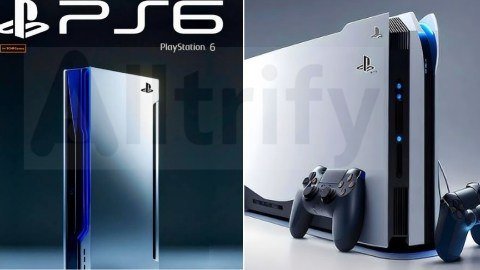Recent developments surrounding the PlayStation 6 (PS6) have generated significant interest within the gaming community. A notable claim suggests that the system-on-chip (SoC) for the PS6 is expected to reach its tapeout by late 2025. This information originated from a reputable source known as Kepler_l2, who has gained a reputation for providing accurate leaks pertaining to PlayStation hardware. With a history of credible insights into prior consoles, Kepler_l2’s latest report has piqued the curiosity of enthusiasts and analysts alike.
Table of Contents
The Latest Report on PS 6 Development
In the context of console development, the term “tapeout” refers to the final stage in designing an integrated circuit (IC), whereby the design is sent for fabrication. This pivotal moment represents a transition from the design phase to physical production, indicating that the hardware design of the PS6 is rapidly progressing. Achieving a tapeout signifies that engineers have finalized the architecture and confirmed that the design meets necessary specifications. For consoles like the PS6, a successful tapeout is crucial as it sets the timeline for further development and eventual production, influencing the release cycle of the final product.
As the gaming industry continues to evolve, the PS6’s anticipated tapeout could herald the next generation of gaming experiences. The integration of advanced technology and powerful SoC is paramount for maintaining PlayStation’s competitive edge. Although specific details remain sparse, the information provided by Kepler_l2 emphasizes the ongoing commitment to innovation at Sony Interactive Entertainment. As fans await further updates, understanding the significance of the tapeout serves as a critical component of the PS6’s development narrative.
Timeline for PS6 Release and Its Implications
The anticipated timeline for the release of the PlayStation 6 suggests a window extending from late 2027 to no later than 2028, as posited by key figures within Sony. Both President Hiroki Totoki and Senior Vice President Naomi Matsuoka have commented on the potential life cycle of the PlayStation 5, indicating that the company is actively contemplating the next generation of gaming consoles. Their insights reflect an understanding of the technological landscape and consumer demands that shape console development.
Historically, Sony has maintained a relatively consistent cycle when introducing new hardware to the market. The PlayStation 4, for instance, was launched seven years after its predecessor, the PlayStation 3. Following this trend, the PlayStation 5’s release in November 2020 positions it for a development cycle that may naturally culminate in the rollout of the PlayStation 6 around the indicated timelines. The six to eight-year span between major console releases has led to established consumer expectations, and as the gaming community grows more sophisticated, the anticipation surrounding new consoles intensifies.
Moreover, the implications of the PlayStation 6’s release extend beyond mere hardware capabilities. The gaming landscape is continually evolving, with new trends such as cloud gaming, virtual reality, and cross-platform play taking center stage. Therefore, the development of the PS6 is not just about maintaining a schedule but responding to technological advancements and shifting user preferences. Sony’s meticulous planning suggests that they aim to meet and exceed the expectations of players eagerly awaiting the next iteration of their beloved platform.
As the projected timeline approaches, the gaming industry will undoubtedly watch closely to gauge how Sony integrates these developments into the PlayStation 6, marking a critical juncture in the company’s storied history.
Technological Advances and Expectations from the PS6
The development of the PlayStation 6 is highly anticipated, particularly regarding the significant technological advances that are expected to enhance gaming experiences. One of the most discussed upgrades is the potential use of AMD’s next-generation architecture, which is rumored to leverage a 3nm manufacturing process. This advancement in chip design is anticipated to offer considerable improvements in both power efficiency and computational performance, providing developers with more capabilities to create rich, immersive gaming environments.
Incorporating a smaller manufacturing process means that the PS6’s hardware could achieve higher clock speeds while consuming less power, thus improving the overall gaming performance. Gamers can expect enhanced graphics quality, characterized by more detailed textures, smoother frame rates, and a more realistic gaming experience. Additionally, the PS6 is expected to push the boundaries of ray tracing technology, allowing for dynamic lighting effects, reflections, and shadows that closely mimic real-world physics. This could transform how virtual worlds are rendered, making them appear more vivid and lifelike than ever before.
Moreover, with high-frame-rate gaming becoming increasingly important, the PS6 could incorporate advanced display technologies that support higher refresh rates. This would not only optimize gameplay for competitive environments where reaction time is critical but also provide a more fluid experience in single-player narratives. As gaming continues to evolve, the expectations surrounding the PS6’s hardware advancements highlight a shift towards a more immersive and high-fidelity gaming experience, setting new standards in the industry.
The Future of Gaming: PS5 Pro vs. PS6
The evolution of gaming consoles has been marked by significant technological advancements. As gamers eagerly await the release of the PlayStation 6, a comparison with the PlayStation 5 Pro offers insight into what future enhancements may entail. The PS5 Pro has already set a high standard in several key areas, and it is essential to examine how these features might carry over or transform in the PS6.
One of the standout features of the PS5 Pro is its advanced storage capabilities, which utilize high-speed SSDs to drastically reduce load times. This innovation not only enhances gameplay but also allows for more immersive experiences. Anticipating the PS6, it is reasonable to expect that Sony will continue to refine storage technology, potentially introducing even larger capacities and faster read/write speeds. Such advancements would enable developers to create more expansive and detailed gaming worlds.
Wireless technologies have also taken a leap forward with the PS5 Pro, featuring improved connectivity and stability through Wi-Fi 6. As the gaming landscape evolves, we can expect the PS6 to build upon this foundation, possibly integrating Wi-Fi 6E or newer standards to further enhance online multiplayer experiences and streaming capabilities. These upgrades could provide gamers with a seamless digital experience, reducing latency and ensuring smoother interactions in expansive online worlds.
Another critical area of focus is video resolution. The PS5 Pro supports 4K gaming, and the transition to the PS6 may include options for 8K resolution, assuming that the necessary display technology becomes more accessible. This potential upgrade in video quality would significantly enhance the visual realism of games, aligning with gamers’ expectations for incredibly immersive graphics.
Backward compatibility remains a crucial topic among gamers. The PS5 Pro has made strides in allowing users to play a vast library of PS4 titles. It is likely that the PS6 will either maintain or extend this feature, providing gamers with the opportunity to enjoy their existing collections while exploring new titles. Such a decision could influence PlayStation’s future strategy greatly, reinforcing loyalty among its user base while appealing to newcomers.





